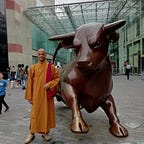More than 2000 years of Myth and Misunderstanding: The Shivalinga
More than 2000 years old misunderstanding, about Shivalinga. Many continue misunderstood Shivalinga as the phallic of male god Shiva or copulation of sexual organs of god Shiva and goddess Parvati. In this matter, over the time, the misunderstanding is caused by limitation of the use of a particular word and the image of the Shivalinga itself can be understood.
The Sanskrit word ‘linga (लिङ्ग)’ generally means sign, marking, symbol, token, reflective image or symptom. In children, not all the symptoms of being man or woman is developed fully yet. So, whether the child would potentially become a man or a woman can only be identified by the genitalia that child born with. If a vagina, the child would be identified as a girl (or proper word would be used as ‘strilingi’, means some who has symptoms or marking or symbol of a female) and if a penis, then the child would be called a boy or proper word would be ‘purushalingi’, means someone with symptoms or marking or symbol of a male. When the child grow older, other symptoms or markings or symbols would develop eventually, like a boy would grow beard, hard muscles, rough skin, flat chest, hyoid bone (in the front neck) etc. And a girl would grow breasts, softer skin, less body hair,, no facial hair, mensuration etc. And minority of children would grow the opposite and they are called the ‘teshro-lingi’ or the third genders.
This is how the word ‘linga’ has been used to identify the children by looking at their genitalia and over time the word ‘linga’ used into this limited context only. Hence, eventually, the word became synonyms to human genitalia. So people started understanding or misunderstanding the meaning of Shivalinga to a male god Shiva’s phallic or penis. Because of to this misunderstanding over the last 2000+ years, the carving of image of Shivalinga also changed and became reflective of a penis.
Modern Shivalingas are carved or constructed like these:
Little older but Shivalingas that are less than 2000 years old are like these:
Whereas, ancient (original) Shivalingas were like these:
So, what actually is reflected or symbolized or marked by the Shivalinga then?
(According to my understanding) Shiva is not a deity of a particular kind, rather the highest stage/status of spiritual practice that one may and can reach, which reflects as the ultimate liberation, mokshya or ultimate happiness. That’s why Buddha used the word ‘Shiva’ also for nirvana or the enlightenment. To achieve this ‘Shiva or Shaivic status’ (according to Bignyana Vhairaba Tantra), one of the many meditation techniques is to meditate on the third eye. Once the third eye gets opened, the Shiva is realized or Shaivic status’ is reached. In Puranas, the image of lord Shiva is always portraited having wide opened third eye. Though the Shiva is portraited always in male form (must have been the reason of strong patriarchy}, otherwise women and third genders also can realize the ‘Shaivic status’, tantra says, even more easily than for the men to realize Shiva.
With Shivalingas, we often see a head raised cobra snake. Generally snakes represent jealousy but a head raised snake symbolizes wakefulness. Meaning wakefully meditate on the third eye.
Lord Shiva has many names, one of them is trilochana, one who has the third eye opened.
What is the third eye and where does it lye?
According to kundilini yogic system, there are 7 chakras (vital-energy center)in a human nerve system and the 6th one is called agnya-chakra is also known as the third eye. The third eye, as told, lies inside the skull between the two normal eyes, below the eyebrows. Normally the third eye remain closed and with meditation one can open it. Once opened, the person can have supramundane power, can see beyond, can realize the truth and get enlightened. The person will be free from all the sufferings and cycle of birth and death.
Scientific secret:
Middle of two sides of the mind, there is a pineal gland, that gland denotes the third eye. The pineal gland produces hormone called melatonin, which plays key role of human functioning of sleeping and awakening. Scientists also say, the melatonin hormone also plays crucial role of our happiness or sadness. It impacts (or the opposite)our mental qualities as well as mental defilements. The pineal gland is supper sensitive to the light, that’s why it may have been called the third eye since ancient times.
Pineal gland, just itself looks like a pinecone that’s why it’s called pineal gland.
But if we look at the whole glad and it’s surrounding, it looks like an eye.
And when one has a vertical overview of this gland, it looks like a ‘Shivalinga’.
In this picture below, from the opened third eye or the pineal gland, the hormone is released into the whole ‘bramnharandra(the universal flow)’, symbolizing the ultimate happiness or realizing Shaivic status.
But this symbol of the third eye is not only limited to Hinduism or Buddhism or just in South Asia. The Vatican’s have given great importance to this pineal gland or the third eye.
One can find third eye in Cambodia:
In Egypt also:
Shivalinga in Jordan:
…and the third eye in the USdollar bill:
Lastly,
Thus the Shivalinga is not phallic of a male god Shiva, which has been the misunderstood-myth over two thousand years period. The word ‘Shiva’ means nirvana, mokshya, ultimate liberation, welfare, ultimate happiness. Similarly the Shivalinga is a symbol, marking, symptom or token image for nirvana, mokshy or ultimate liberation, ultimate happiness.
भवतु सब्ब मंगलम् !
Bhikshu Kashyap
